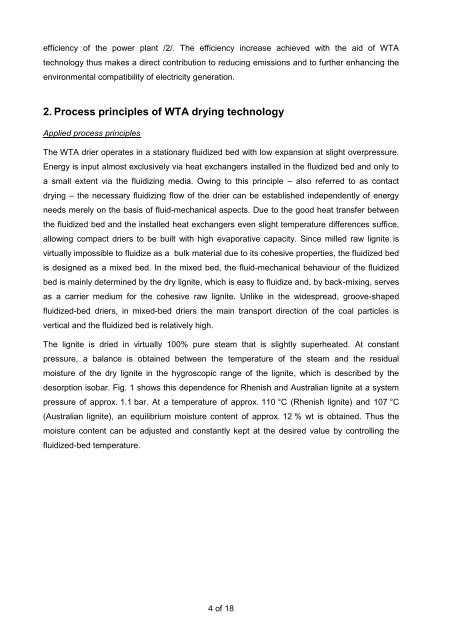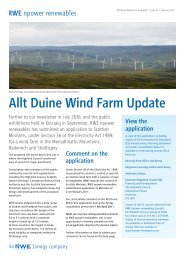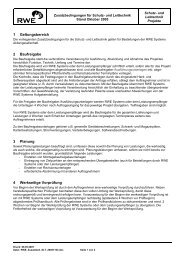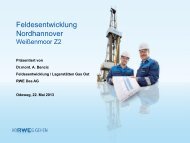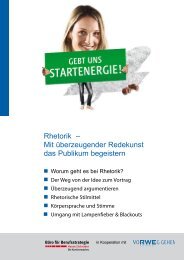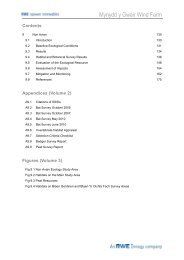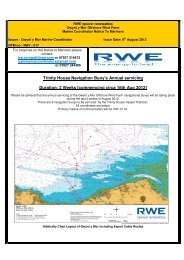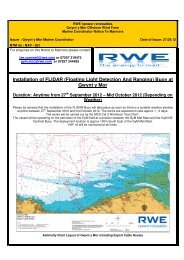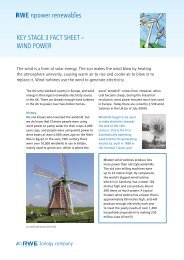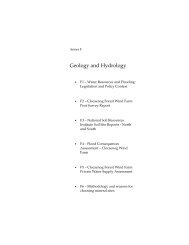Development status of WTA fluidized-bed drying for - RWE.com
Development status of WTA fluidized-bed drying for - RWE.com
Development status of WTA fluidized-bed drying for - RWE.com
Create successful ePaper yourself
Turn your PDF publications into a flip-book with our unique Google optimized e-Paper software.
efficiency <strong>of</strong> the power plant /2/. The efficiency increase achieved with the aid <strong>of</strong> <strong>WTA</strong><br />
technology thus makes a direct contribution to reducing emissions and to further enhancing the<br />
environmental <strong>com</strong>patibility <strong>of</strong> electricity generation.<br />
2. Process principles <strong>of</strong> <strong>WTA</strong> <strong>drying</strong> technology<br />
Applied process principles<br />
The <strong>WTA</strong> drier operates in a stationary <strong>fluidized</strong> <strong>bed</strong> with low expansion at slight overpressure.<br />
Energy is input almost exclusively via heat exchangers installed in the <strong>fluidized</strong> <strong>bed</strong> and only to<br />
a small extent via the fluidizing media. Owing to this principle – also referred to as contact<br />
<strong>drying</strong> – the necessary fluidizing flow <strong>of</strong> the drier can be established independently <strong>of</strong> energy<br />
needs merely on the basis <strong>of</strong> fluid-mechanical aspects. Due to the good heat transfer between<br />
the <strong>fluidized</strong> <strong>bed</strong> and the installed heat exchangers even slight temperature differences suffice,<br />
allowing <strong>com</strong>pact driers to be built with high evaporative capacity. Since milled raw lignite is<br />
virtually impossible to fluidize as a bulk material due to its cohesive properties, the <strong>fluidized</strong> <strong>bed</strong><br />
is designed as a mixed <strong>bed</strong>. In the mixed <strong>bed</strong>, the fluid-mechanical behaviour <strong>of</strong> the <strong>fluidized</strong><br />
<strong>bed</strong> is mainly determined by the dry lignite, which is easy to fluidize and, by back-mixing, serves<br />
as a carrier medium <strong>for</strong> the cohesive raw lignite. Unlike in the widespread, groove-shaped<br />
<strong>fluidized</strong>-<strong>bed</strong> driers, in mixed-<strong>bed</strong> driers the main transport direction <strong>of</strong> the coal particles is<br />
vertical and the <strong>fluidized</strong> <strong>bed</strong> is relatively high.<br />
The lignite is dried in virtually 100% pure steam that is slightly superheated. At constant<br />
pressure, a balance is obtained between the temperature <strong>of</strong> the steam and the residual<br />
moisture <strong>of</strong> the dry lignite in the hygroscopic range <strong>of</strong> the lignite, which is descri<strong>bed</strong> by the<br />
desorption isobar. Fig. 1 shows this dependence <strong>for</strong> Rhenish and Australian lignite at a system<br />
pressure <strong>of</strong> approx. 1.1 bar. At a temperature <strong>of</strong> approx. 110 °C (Rhenish lignite) and 107 °C<br />
(Australian lignite), an equilibrium moisture content <strong>of</strong> approx. 12 % wt is obtained. Thus the<br />
moisture content can be adjusted and constantly kept at the desired value by controlling the<br />
<strong>fluidized</strong>-<strong>bed</strong> temperature.<br />
4 <strong>of</strong> 18


